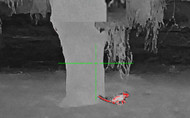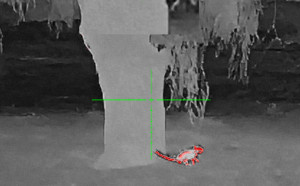Punishing Pesky Pests With A Budget-Friendly Thermal Scope
Posted by PardUSA on Oct 7th 2025
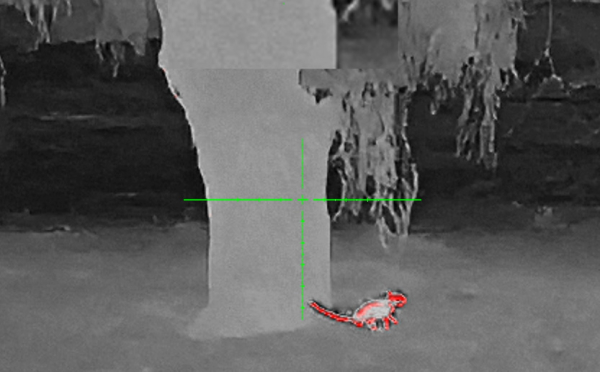
By Jeremy S.
While on our suppressed dove hunting trip in the southernmost tip of Texas, Dan busted out his new $899 MSRP thermal scope to show it off. That was a big mistake as I immediately stole it and mounted it on a .22LR machine gun that happened to be in my trunk.
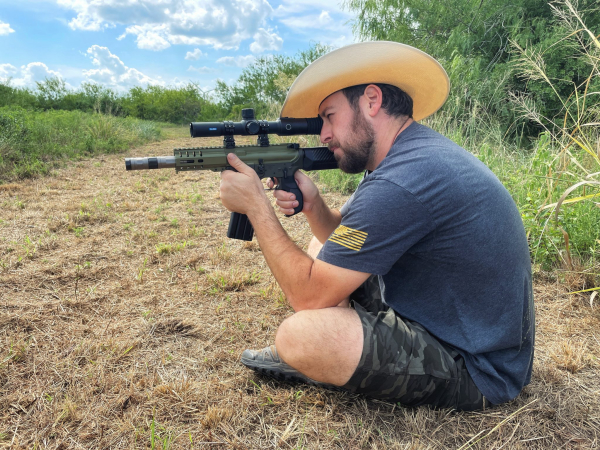
While the rest of the crew went sightseeing at the SpaceX Starbase launch facility in Boca Chica, Texas (what are the odds?), I sweated my ass off sighting in four different guns in 96-degree, 96-percent weather. Naturally, the new thermal was at the top of the list as the property was crawling with nighttime critters and I dang sure wanted to stay up late to hunt them…and hunt we did!
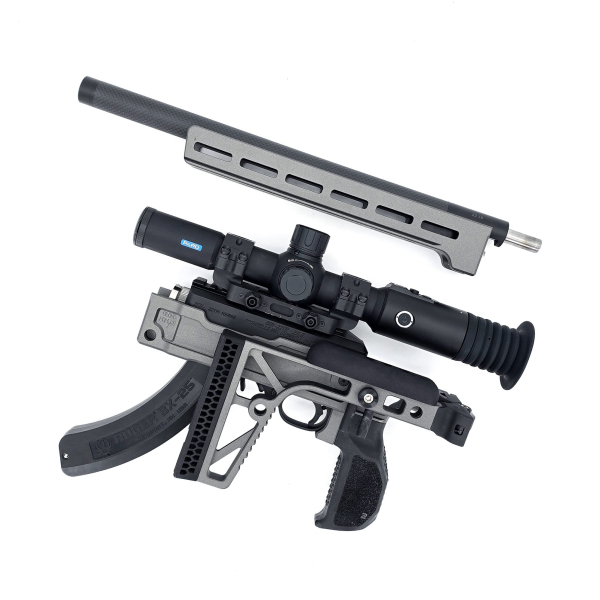
Sighting in the PARD Pantera 256 Q Thermal Scope was very easy and can be accomplished with a single shot (if you trust your gun’s — and your — accuracy). Take your best shot at the bullseye, line up the reticle exactly on the bullseye, and click into the reticle adjustment menu. On your click, the Pantera freezes the image. If you were smart enough to shoot at a target with a good backer like a sheet of plywood or multiple layers of cardboard, you’ll have about 30 seconds to freeze that image with the still-hot bullet hole clearly visible on the target.
Now simply rotate the top turret and walk the reticle from the bullseye to your errant bullet hole, then press-and-hold the turret to save that setting. The display then quickly refreshes to move the image so your reticle is centered on the screen. Now your point-of-impact matches your point-of-aim. Genius.
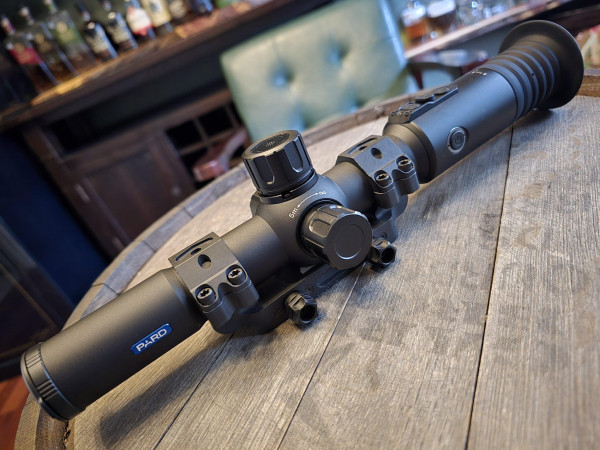
What we have here is the PARD Pantera 256 Q thermal scope. It comes in a super nice box complete with tall rings (seen on the .22LR AR two photos up…I later switched those for a lower height QD mount seen in the photo immediately above), caps, cleaning cloths, a 18650 battery, charging cable, tools, and manual. All for an MSRP of $899.
I know, I know, $899 is still a lot of money. But relative to other thermal optics, that’s a screamin’ bargain.
With lower expectations to match the Pantera’s low price, we more or less set out to find “the catch” that would make clear what the Pantera 256 Q lacked versus a more typical $3,999 thermal optic.

First impressions, however, were good. We all liked the standard riflescope form factor and the PARD’s light weight (about 17 ounces).
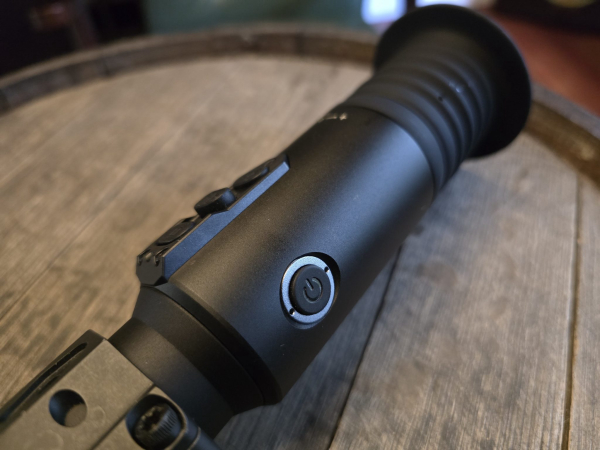
On/off is controlled via the power button on the left side of the ocular housing. A quick click puts it to sleep or instantly wakes it back up, while holding it for a couple seconds turns it on or off. I like how this button is off on its own and doesn’t serve additional functions. It’s a power button and it takes care of power stuff. Me simple, me like.
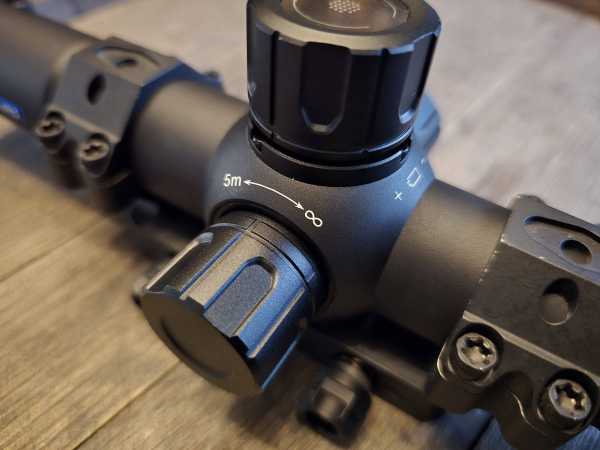
The left-side turret, which on a traditional riflescope would be your parallax adjustment (which many folks refer to as “side focus”), is the objective lens focus dial to match image focus to your target’s range. This is intuitive and easy-to-reach. The knob rotates smoothly with just the right amount of resistance.
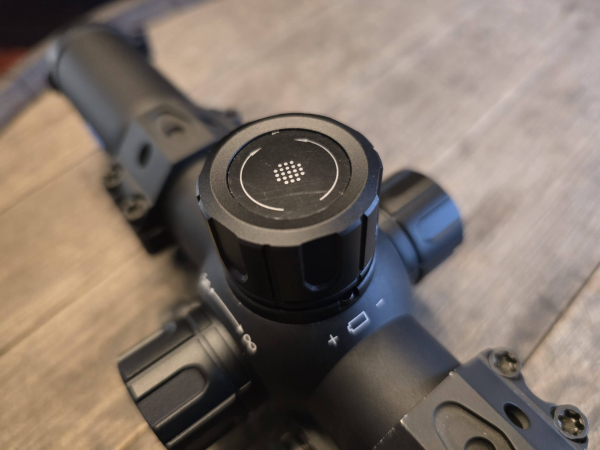
Up top, where you’d normally find an elevation turret is your primary menu navigation control. The turret/dial/knob rotates to move through the menus and settings and clicks downward toward the scope to make selections. It’s a fairly intuitive system similar to what you’ll find in a lot of vehicles these days.
When you’re out of the menus and in hunting mode, rotating the top turret zooms in or out through the Pantera’s 2x/4x/6x/8x magnification settings. Double-clicking it turns the picture-in-picture display on or off.
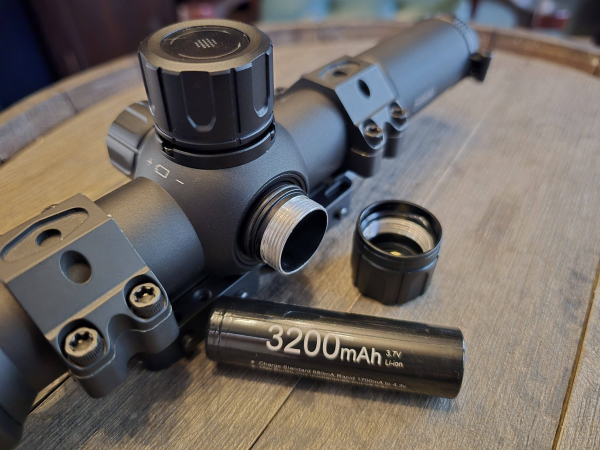
Over on the right side, which would normally be your windage turret, is the battery compartment. Unscrew the cap and a single 18650 rechargeable lithium ion battery drops down inside. PARD says you’ll get up to six hours of run time out of that battery and I think that’s possible, but not highly likely. More on that later.
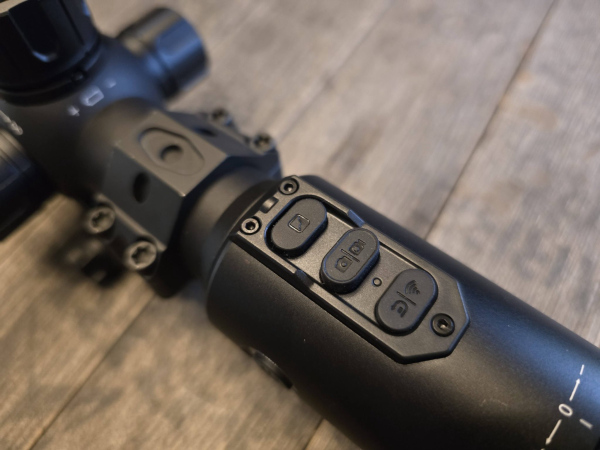
On top of the ocular housing are three buttons, the middle one being noticeably taller so you can easily orient your button-pushin’ finger in the dark.
Clicking the farthest forward button cycles through the Pantera’s five image modes (explained via photos later), holding it cycles through the three different scene modes (city/rain/forest).
Clicking the center button snaps a photograph or starts/stops video recording with a couple of seconds press-and-hold. By double-clicking this button you’ll access the files stored on the Pantera’s 32GB of internal storage.
The closest button, with a single press, is an automatic “back” from whatever menu or setting you’re on, and it turns WiFi on and off with a press-and-hold. Double-clicking it starts the shutter correction function if you’ve previously gone into the menus and switched shutter correction from auto to manual, which I wouldn’t generally suggest.
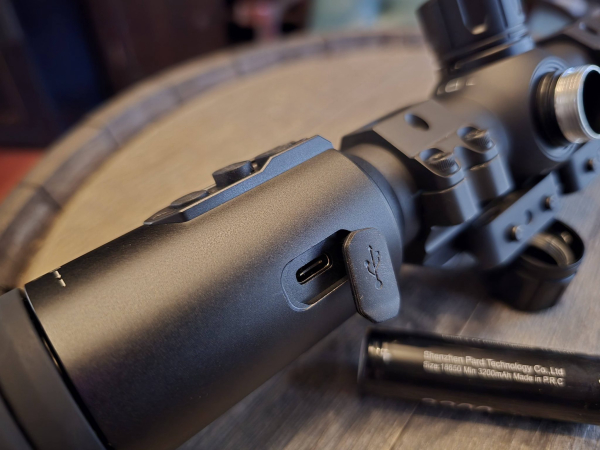
Finally, on the right side of the ocular housing is a USB-C plug. This can be used to charge the battery while it’s still installed in the Pantera, which is nice, and can also be used while the optic is running.
Some guys prefer to carry extra batteries and swap them out as needed. Some prefer to plug in an external power bank large enough to keep the optic online throughout the night. It’s great that the Pantera 256 Q accommodates both options.
Images and videos stored on the optic can be transferred out via WiFi (to your phone using the PardVision2 app is easiest) or via th USB-C plug by connecting the Pantera as an external USB storage device.
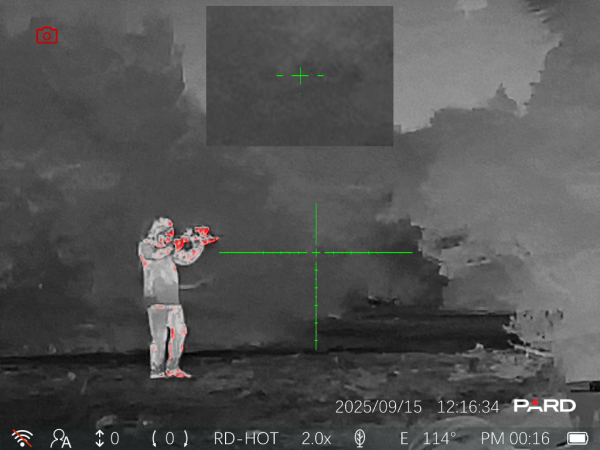
While Steve scoped out the property using a $4,499 thermal clip-on on a Black Collar Arms Piglet Takedown SBR, I had my Frankenstein machine gun taken apart so I could get familiar with the PARD’s menus and settings without pointing a functional firearm at him.
I chose my favorite of six different reticles and four different reticle colors. I settled on a 2x zoom, though 4x, 6x, and 8x digital magnification are available in addition to the scope’s 3.6x optical magnification. For an as-needed magnification assist I added a PIP (picture-in-picture) display up top. I’ve found it faster to have the large display zoomed out for maximum field of view and clarity and a smaller PIP, which is always 2x whatever your primary magnification is, displayed for precision shots rather than messing with the magnification on the primary display while hunting. That said, if having two reticles weirds you out, moving through the Pantera’s magnification range via turning the top turret is about as easy as it gets on a thermal.
There’s a bunch of information seen in my screenshots here across the bottom of the display, which can be turned off in the display settings menu and can be moved between top/bottom/right — most items can also be toggled on/off individually — but I left it all on as I thought it was pretty spiffy. The very affordable PARD displays whether or not the WiFi is on, which profile is loaded, gyroscope information (scope tilt and cant), image mode, magnification level, scene mode, compass heading, time, and battery status.
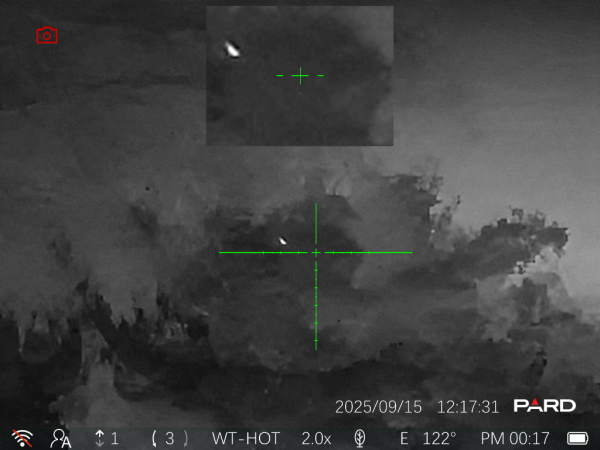
Seen above is White Hot image mode. That’s a rat in the tree to the left left and just up from the crosshair.
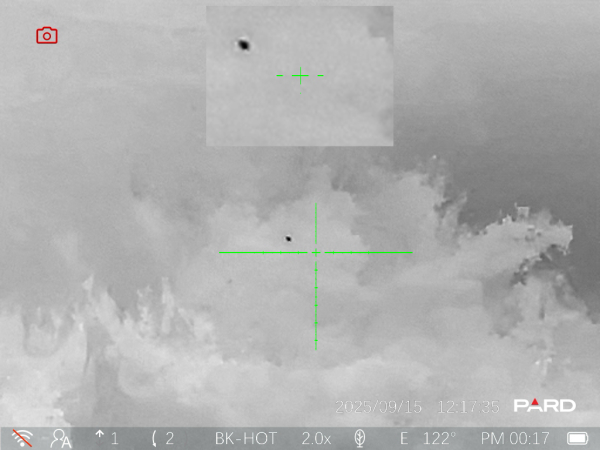
There’s Black Hot.
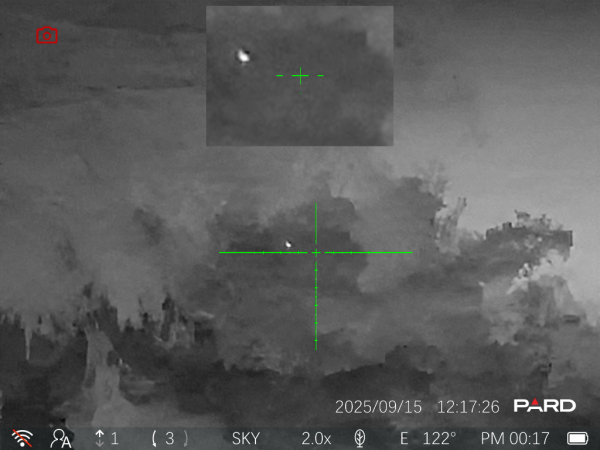
“Sky” mode, whatever that is. (“The Sky mode provides an alternative visual representation of the thermal image, which can be beneficial for highlighting specific targets or features depending on the user’s needs and the surrounding environment.”)
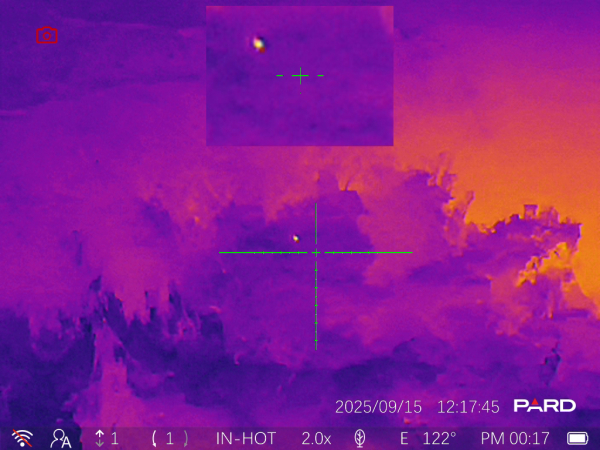
IN-HOT AKA Iron-Hot, which is always a bit crazy and looks straight out of Predator.
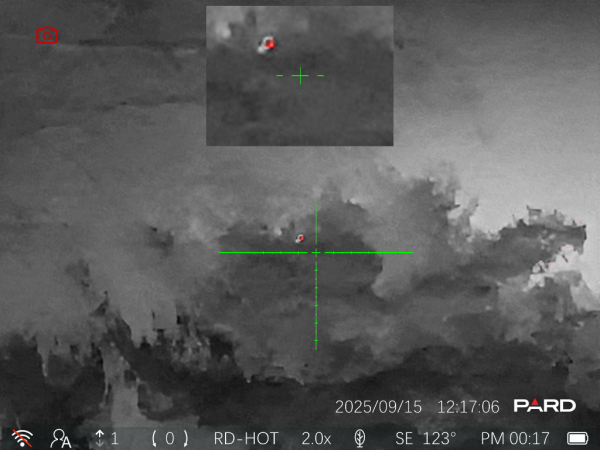
Finally there’s Red-Hot, which is where I left it the whole night while hunting. The $899 PARD Pantera does a really fantastic job of precisely recognizing the heat signature of an animal and highlighting it in red.
Mind you we were hunting in hot, humid south Texas weather and that makes the job of a thermal optic pretty darn tough. The Pantera’s ability to “recognize” and highlight an animal in a landscape where everything is near-mammal-temperature was truly impressive, and it was able to do that out to much farther ranges than we expected.
This little optic also has a Hot Track function, which the owner’s manual describes as, “The device can detect and display the highest temperature point on the screen, and automatically track this target heat source.”
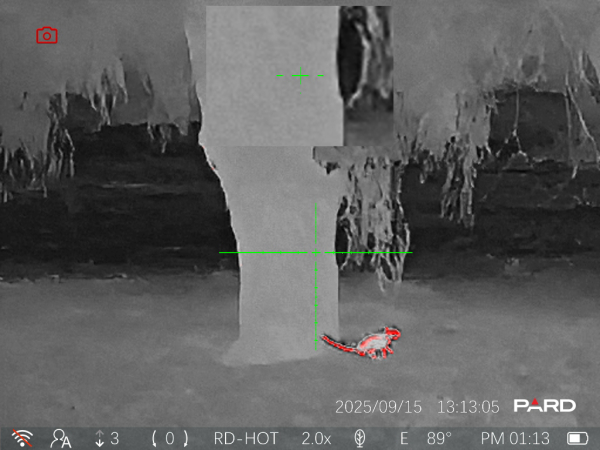
That’s a big ol’ rat.
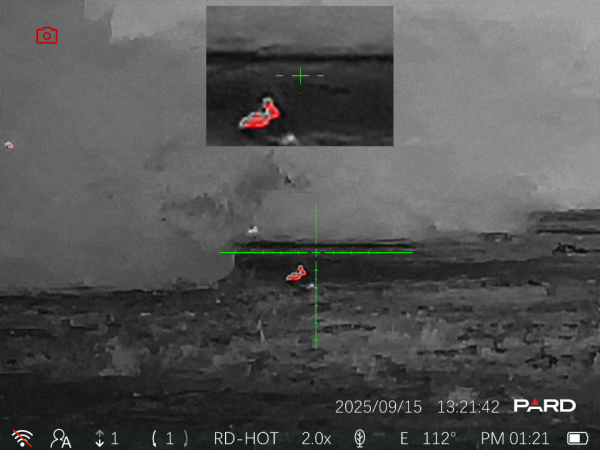
That’s a cute, delicious bunny rabbit. There’s another rabbit behind and to the left of that one and there’s a rat up in the tree at the left edge of the display. Nothing can hide from this thing. You can see animals buried in trees and bushes that you’d never see otherwise, night or day.
While video recording can be started manually or can be set to record all the time and automatically loop every 1, 10, or 30 minutes, it can also be set to self activate based on recoil. The Pantera will constantly loop-record 20 seconds at a time, and when recoil is detected it’ll save the previous 20 seconds of video and after the shot to the internal storage.
I appreciate how the budget PARD has recoil sensitivity adjustment (low/medium/high). I believe it caught all of my light-recoiling .22LR shots with no false alarms. For the record, the other $4,499 optic we had with us automatically recorded two videos because it apparently got bumped and mistook that for recoil.

In The Field
Bottom line up front: I have no meaningful complaints about the performance of the PARD Pantera 256 Q. In fact, I pretty much love the thing.
It fell a little short in only one area for me, which is that it’s not very good at determining battery charge level (something that’s notoriously difficult to do with lithium ion batteries). It took about an hour for the display to drop, in one step, from full charge to about 2/3, and then an hour or so later it dropped from there to one little red bar at the bottom…yet still lasted a really long time after that point.
The Pantera’s battery life is actually quite impressive — I used it for about four hours and quit hunting before the battery died — it’s just that the charge level display isn’t particularly helpful.
Images and pictures above were taken with the “PARD super resolution image algorithm” running. This likely uses extra battery juice and is described in the owner’s manual as:
PARD super resolution image algorithm has fast processing speed and strong real-time image adaptability, which can effectively improve image detail by correcting image distortion, reducing noise and enhancing contrast.
It appears this “super resolution” works quite effectively, as the image and contrast and detail from this 256×192 pixel sensor and 25mm objective lens are far better than you’d expect. Even compared directly against a very good, much more expensive thermal, the PARD truly held its own here.
Its ≤25mK sensor (meaning it’s sensitive enough to distinguish between 0.045-degree F differences in temperature) was capable of picking out small animals like rats, opossums, rabbits, and more out to at least 150 yards and likely much farther. I was able to clearly see the wind turbines in the distance, which absolutely stretched and almost certainly exceeded PARD’s claimed 1,200-meter detection range.
Correctly identifying animals through a thermal is a bit of a trick, which I continue to get better at given more time looking through thermals at more animals. While I’ve seen sharper imaging through thermals with larger objective lenses and larger sensors, we were extremely surprised with the quality, contrast, and sharpness of the image through the Pantera.
We had no problem easily and clearly distinguishing rabbits from rats, an ocelot (that was cool to see!), raccoons, opossums, etc. It’s plenty sharp and clear enough with its 50 Hz frame rate to recognize a javelina from a hog, a nilgai from a horse, a raccoon from an opossum, a coyote from a pet dog, etc., based not only on appearance but, even more importantly when viewing through a thermal, on the animal’s behavior and how it moves.

Pest hunting was a success, and I came home with a couple of pounds of rabbit meat. A few of the critters were a bit gross (excessive fleas/ticks/other issues) and were left for the local scavengers to feed on, but most of the bunnies were as clean as household pets and will be delicious.
For the price, it’s undoubtedly hard to beat the PARD Pantera 256 Q. We haven’t hammered on it enough yet to determine long-term durability, though it’s definitely worth mentioning that it comes with a three-year warranty, which PARD extends to five years if you register your optic through their website.
Bottom line: I’m keeping the Pantera in active use, whereas last year I shelved a different, far more expensive thermal scope because I found it annoying to use. At about a quarter of the price, this lightweight scope is far more user-friendly and is perfectly capable of putting meat on the table.
Specifications: PARD Pantera 256 Q Thermal Scope
Sensor Type: Uncooled VOx(vanadium oxide)
Sensor Resolution: 256×192 pixels
Pixel size: 12×12 µm
Frame rate: 50 Hz
Detection distance: 1200 meters
Objective Lens: 25mm
Battery TypeL Lithium Ion 18650
Optical Magnification: 3.6X
Digital Zoom: 2/4/6/8X
Focus range: 5m to ∞
Eye Relief: 50mm
Display Type: OLED
Reticle Style:6
Reticle Color: Red/White/Yellow/Green
Photo Resolution: 1024×768 pixels (jpg)
Video Resolution: 1024×768 pixels (mp4)
Storage: Built-in EMMC 32GB
MSRP: $899

